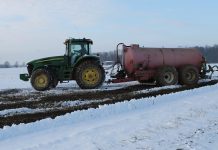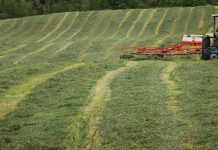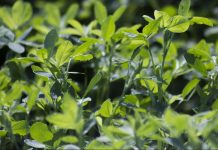Water has been endlessly circulating since the earth was formed. Groundwater is a key part of this continuous cycle as water evaporates, forms clouds and returns to the earth as precipitation.
Precipitation that soaks into the ground and is stored in underground geological water systems called aquifers is known as groundwater. Springs, lakes, and other surface waters are fed by groundwater as well as drinking water supply through man-made wells.
How important is groundwater? It is a diverse natural resource that is used for drinking, recreation, industry and irrigation. According to 2005 U.S. Geological Survey figures, groundwater accounts for 37 percent of agricultural use — mostly for irrigation.
Groundwater accounts for 37 percent of public water use withdrawals and 99 percent of drinking water supply for the rural population.
Nearly 75 percent of the water that comes to our homes goes down the drain. It is our responsibility to make sure that waste water is not causing contamination to groundwater supply.
Contamination.
Man-made products such as gasoline, oil, road salts and chemicals can cause problems if not disposed of properly or leaking from storage containers.
Do not dispose of chemicals by drain-dumping, evaporation, burying or putting out for garbage pickup. Take advantage of local hazardous waste collection events and let qualified individuals deal with the materials.
Septic systems are designed to slowly and harmlessly treat human waste underground. Poor design, location, construction and maintenance on a septic system can hinder the purpose and cause bacteria and viruses to leak into groundwater.
Know where the system drain field is and know its capacity. Keep good vegetative cover on the drain field. Surface water runoff should be diverted away from the drain field to prevent an overload.
Unnecessary products such as paint, waste oils, pesticides, medications, diapers and feminine hygiene products should never be in the system.
Before the mid-1970s there was a misconception that soil provided a protective filtering process that stopped pesticides from reaching groundwater. Surface application of a chemical on cropland or an urban lawn can result in contaminated water within an aquifer.
Other contamination sources can include seepage of polluted surface water, accidental spills and leaks and improper disposal.
Data from a 2001 study from the U.S. Geological Survey shows that pesticides are commonly present in streams and groundwater at concentrations that affect aquatic life and the surrounding wildlife.
Effects.
The benefits of increased food production and beautiful lawns from pesticide and fertilizer chemicals can be quickly dismissed by the adverse effects on the environment. Know and understand the chemical and its effects before you apply it to your vegetation.
Other contaminant sources include storage tanks, hazardous waste sites, landfills, poorly maintained feedlots, and toxic substances from mining sites.
It is estimated that there are over 10 million storage tanks buried in the U.S. — that is an incredible number of accidents waiting to corrode, crack, or leak their way into our water supply. Currently there are over 20,000 abandoned and/or uncontrolled hazardous waste sites, with that number growing every year.
Landfills are a necessary evil that creates the potential for us to poison our environment and water with a faulty protective bottom layer leaking paint, household cleaners, car battery acid and various other harmful substances.
Livestock feedlot areas that are poorly maintained allow animal waste material to run off site causing excess nitrogen to enter our waters.
Waste control.
Pet owners are not exempt from the concern of animal waste. Animal manure contains nitrogen and bacteria levels that could upset algae growth and promote undesirable weeds. Pet waste should be scooped and thrown away in a sealed bag to be safe.
Fifty percent of the U.S. population depends on groundwater for daily drinking water, therefore, it is so important to protect yourself and be aware of potential dangers in your water.
In addition to the aforementioned safeguards, homeowners can install a rain garden and/or rain barrel, get private well water tested once a year, and limit water use and consumption. A rain garden is designed to temporarily hold and slowly soak in rain water runoff.
Rain barrels can be designed to catch surface water from your home and other buildings and used later to water plants instead of turning on the garden hose. Having your well water tested once a year allows you to address specific problems in the water supply if they arise.
Another option.
You can also track changes over time and possibly determine the cause more easily. Some health departments can perform the test or can refer you to a certified laboratory in your area. Simple changes like taking shorter showers and fixing a leaky faucet can help with water conservation.
Get involved in water education Last but not least, following healthy conservation habits gives you the opportunity to educate someone else through personal experience.
If water education is something you want to tap into, we have resources, including education programs available for presentation to schools and groups. Resources include Enviroscape model demonstrations on Non-point Source Pollution and Drinking Water and Waste Water Treatment and a Groundwater Model that illustrates what happens to water once it soaks through the ground.
Contact your local SWCD office to find out if they offer these services.
(Facts obtained from the USGS Website and the Groundwater Foundation website.)












